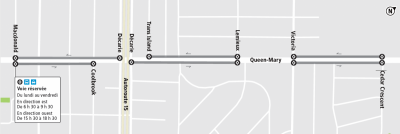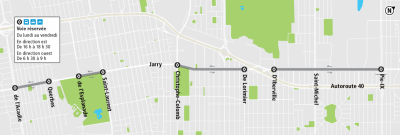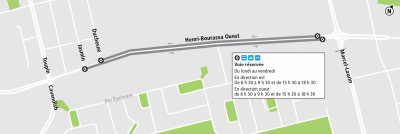Continuing the Mouvement bus 2025 vision, the STM will be adding 10.8 kilometres of reserved lanes to the current network, with the support of the City of Montréal.
Montréal, November 4, 2022 – Customers of the STM bus network will soon benefit from even more timely and reliable travel, as three new reserved lanes on Jarry, Queen Mary and Henri-Bourassa West, along with a pull-off lane on Sherbrooke East will be rolled out in November. Cyclists will also be able to use some of these new features. To achieve the Mouvement bus 2025 vision, the STM will be adding 10.8 kilometres of reserved lanes to the current network, with the support of the City of Montréal.
“The implementation of these reserved lanes is part of the STM’s and City of Montréal’s joint action plan to strengthen the bus network and improve its flow, reliability, and, by extension, overall performance and appeal. These new measures will improve service for more than 20,000 trips, allowing Montrealers who choose sustainable mobility to enjoy better travel conditions,” says Éric Alan Caldwell, Chair of the STM Board of Directors.
Since November 1: Pull-off lane on Sherbrooke Street East
An eastbound lane on Sherbrooke, at the corner of De la Rousselière, was narrowed and removed, making it difficult for buses to get around and causing delays. Implementing a permanent pull-off lane for buses, taxis and cyclists will improve bus flow, increase safety and reduce travel times.
As of today, November 4: Reserved lane on Queen Mary Road
Queen Mary is a critical transit corridor, as 60% of trips in this area are made by bus, and line 51 is the busiest bus on the STM network. Lines 51 and 166 serve over 35,000 customers. During consultations on the bus network redesign, many people had asked for measures to improve bus punctuality in this corridor. This new reserved lane for buses and taxis, which will be 2.2 kilometres in both directions between Macdonald and Cedar Crescent, is an ideal solution for improving timeliness and reliability on lines 51 and 166. It will run eastbound from 6:30 a.m. to 9:30 a.m. and westbound from 3:30 p.m. to 6:30 p.m.
Later this fall: Reserved lane on Jarry Street
A new reserved bus-and-bike sharing lane, which will be 6.9 kilometres in both directions, will be implemented on Jarry Street between Acadie and Pie-IX. It will run westbound from 6:30 a.m. to 9 a.m. and eastbound from 4 p.m. to 6:30 p.m. Customers of line 193—which serves more than 13,000 riders per day—will benefit from better service with improved travel times and increased bus punctuality. Letting cyclists use the reserved lane will also offer them a safer option than what they currently have. Work on the lane is currently underway.
Later this fall: Reserved lane on Henri-Bourassa Boulevard West
Upcoming major residential and commercial real estate projects and the arrival of the REM, which will connect to the future Bois-Franc station, will increase the already significant mobility needs on Henri-Bourassa Boulevard West between Toupin, Cavendish and Marcel-Laurin. As a result, the STM will extend the reserved lane, which was implemented in 2017 and currently runs between Cavendish and Marcel-Laurin, west of Place Vermandère by 1.7 kilometres in both directions. This will benefit the 2,000 daily riders of lines 171 and 215 in this section, better meet the travel needs in the coming years, and encourage road-sharing for taxis and bikes. This new section will have the same hours as the existing reserved lane: Monday to Friday, from 6:30 a.m. to 9:30 a.m. and 3:30 p.m. to 6:30 p.m. Work on the lane is currently underway.
Continuing the work
“Mouvement bus is about providing Montrealers with city-wide access to fast, frequent and efficient transportation services within walking distance of their homes and workplaces. As we shift to a more environmentally conscious way of life, it is our responsibility to offer greener, more efficient travel options,” says Mr. Caldwell. “We are moving towards this objective with the implementation of these three new reserved lanes on major transit corridors, and it is essential that we continue doing the work.”



